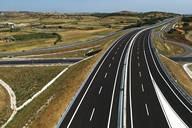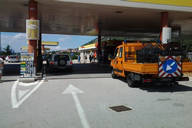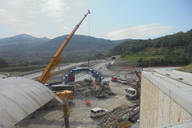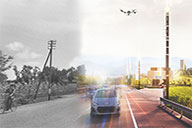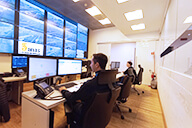Innovation and technology are part of our DNA and for us this means "building understanding" of the challenges we will face in the near future in order to "create our future" and help shape better road transport infrastructure. The constant evolution of technologies and materials in our field of activity opens new perspectives for the management of road safety, surveillance, maintenance and works. This is why we are constantly testing new solutions and developing new procedures and materials, cooperating with research centres and promoting innovative projects at a national and international level.
In this sense, our Cesano Research Centre (CSS) is a pole of excellence for research, development and advisory activities.
We use technology to:
Build the roads of the future. Anas cooperates with Italy's and Europe's main research centres, offering advisory services, experimental tests on materials and on road management technologies.
Protect our customers. The technological solutions we adopt aim to drastically reduce accidents and the number of road victims.
Make travels safer and more comfortable. Monitoring and traffic information systems on our network contribute to make the flow of traffic smoother and permit us to promptly provide traffic information, report emergencies or other forms of danger.
#SmartRoad
Our goal is to lead Italy towards the digital transformation of its road infrastructure, in order to provide services that facilitate mobility and the monitoring of road works, through the development of a network of smart roads that are "connected" to and interact with road users. In 2016 we invested 160 million euro for the technological transformation of 3,000 kms of the road network we manage and planned investments in this field are significant: 225 million euro for phase 1 (a large part of which have been initiated), 365 million in phase II and 210 million in phase III.
The challenges linked to "smart and sustainable mobility" cannot be faced just by building new infrastructure or adopting new technologies: a broader strategic approach is required to design a completely new "integrated transport system" for a "smart" management of mobility. We are focusing on our “Smart Road” project in order to introduce advanced technologies that improve road safety, sustainability and accessibility on our network through a “Digital Transformation” (DT) that provides innovative services and solutions that meet the needs of road users.
We aim to offer travelers real time information on road and traffic conditions through advanced technologie that connect them to the road infrastructure. In this sense innovative solutions and platforms are being identified (by means of "in motion connectivity systems") to cancel the distance between road users through Vehicle To Infrastructure (V2I) and Vehicle To Vehicle (V2V) communication and DSRC (Dedicated Short Range Communication) technologies in the near future will make all of this possible.
With Smart Roads the technological infrastructure will also be equipped with innovative video surveillance systems, such as drones, that will allow monitoring of the state of the infrastructure even in areas difficult to access. The technological infrastructure will also be equipped with innovative video surveillance systems, such as drones, that will allow monitoring of the state of the infrastructure even in areas difficult to access by traditional means.
At a global level, projects are also being developed to incorporate technologies into roadways in order to generate solar energy, install more efficient lighting and monitoring systems and to improve forms of communication and of integration with self-driving vehicles.
In the near future roads will no longer only be considered "civil engineering works". Through the incorporation of sensors, feedback loops, Internet of Things (IoT) networks, and other technologies roads not only will become navigable, but they will also become insightful. Information will be shared with road users, and among road users, improving general road safety and conditions. Also data concerning important events will be processed and collected to guarantee prompt interventions, smarter maintenance and an increase in road operation efficency.
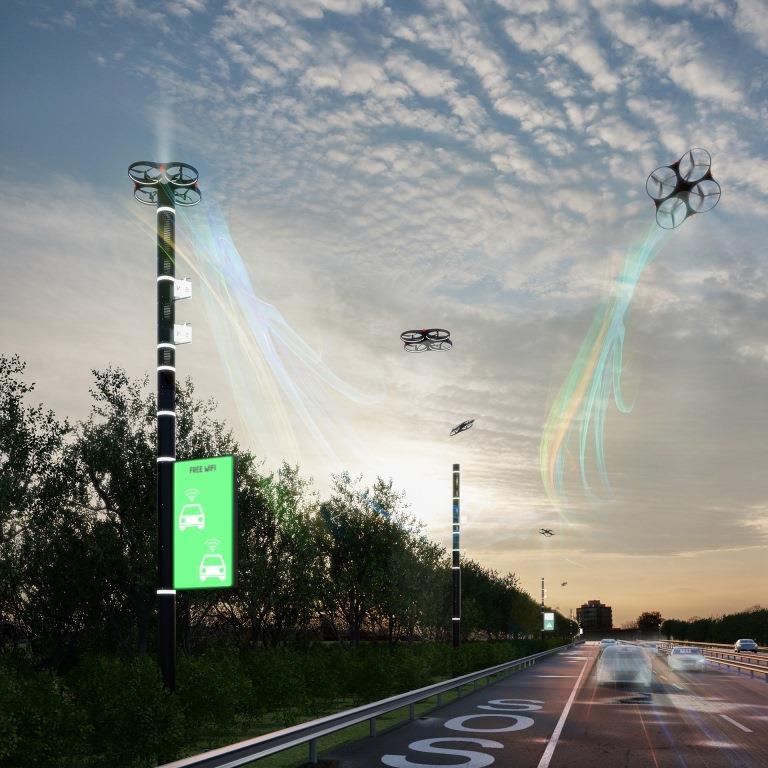
Smart Road – Connectivity
Smart Roads, equipped with a MPLS (Multi Protocol Label Switching) network along the entire length of a road, enable the sharing of data on a single platform.
More in detail, specific Smart Road wireless systems ensure connection between road users when they are traveling on board of their vehicles. Considering the widespread popularity of mobile devices, the possibility to provide drivers with real time infomobility and road safety information services through APPs can be guaranteed by equipping the entire road network with a dedicated Wi-Fi connection that functions within certain speed limits (130 km/h).
Vehicle to Vehicle connections and Vehicle to Infrastructure connections will also promote the development of semi-automatic or autonomous driving systems that adopt "Dedicated Short Range Communication" (DSRC) technologies based on European standards.

Smart Road - Energy and environmental sustainability
We care about the environment and are working on sustainable technological solutions for energy sources: the core of our energy system will focus on “Green Islands” along our roads. In recent years the concept design of multifunctional poles and "Green Islands" was developed in collaboration with important research centres, and this will allow the autonomous generation and distribution of energy from renewable source, the recharging of electric vehicles, the recharging and the housing of drones. These islands will provide enough power for the Smart Road systems installed along each road and to recharge electric vehicles and drones.
Our Smart Road technologies will first be introduced on our A2 “Autostrada del Mediterraneo” motorway. Other roads that will also be part of this project are Rome's Grande Raccordo Anulare (GRA), the A91 Rome-Fiumicino motorway, the Orte-Mestre itinerary on the E45 and E55 itineraries, the A19 Palermo-Catania motorway and the city of Catania's Tangenziale (Ring road).
#Greenlight
Saving energy is another goal we pursue during the planning, design, construction, management and maintenance of the road and motorway network we managsand its technological systems.
We are increasingly focusing our attention on "energy efficiency and saving measures", through the use of specific, cutting-edge equipment and technology. More in detail great attention is placed on "monitoring" energy consumption already during the "design phase" of road projects, thanks to specific software that enable the remote monitoring of lighting systems and of their functioning.
At the end of 2016 a multi-year project called #greenlight - with a total investment of 155 million euro - was approved by our Board of Directors and launched to reduce tunnel energy consumption for lighting while maximizing visibility and safety.
We have identified 708 tunnels (out of a total of 1,900 tunnels on our network) in which, with priority, conventional luminaires are being replaced with more efficient lighting systems based on the latest LED technology, which delivers better driver experience in tunnels, where visibility and the quality of artificial light diffusion improves, at lower costs. In addition, the high colour rendering index, luminous efficiency and high visual comfort of LED equipment enables us to lower the luminance level on the road surface which translates into considerable energy savings.
The #greenlight project has two phases. With regard to the first tranche of investments, we already pubblished a three-year framework agreement for a total value of 45 million euro that will be invested between 2017-2019 in 200 tunnels. The second tranche provides another 110 million euro, and will be activated later.
#Greenlight project info-graphic

We are also installing "luminance sensors" at each tunnel's entrance so that we can adjust the internal lighting levels according to outside luminance, with point-by-point adjustments. Also a system upgrading programme is currently underway for other tunnels to ensure relevant energy savings.
European Research Projects
In recent years we developed three projects and respondend to EU research calls and funding under the LIFE + and HORIZON 2020 programmes:
- OMERO - Horizon 2020
- WIN - Horizon 2020
- QUIERNESS - Life 2015
In this same period we continued to conduct our activities within research projects that already have been funded (INFRAVATION, DISTANCE and DYNAMAP).
Dynamap is a LIFE project that is co-funded by the European Commission. It aims to develop a dynamic noise mapping system that detects and represents the acoustic impact generated by road infrastructures in real time.The project stems from the need to make the preparation and upgrading of “noise maps” - through a fully automatic "integrated" system for data acquisition and processing - easier and less costly, which is required every 5 years by the European Directive on environmental noise.
The system consists of a network of sensors which are located along the infrastructure, in appropriate positions, that continuously measure traffic noise levels and is managed by a software implemented on a GIS platform that updates and reports noise maps in real time..
Dynamap has been implemented in two pilot areas with different environmental and territorial characteristics: an urban center and a major road. The first pilot area is located in Milan while the second pilot area is located in Rome, along the A90 motorway (the so-called Grande Raccordo Anulare). One year of testing was done to verify the systems efficiency, effectiveness and reliability.
For more information: http://www.life-dynamap.eu/
Research and Experimental Projects - The Cesano Research center
Technological innovations are fundamental in road maintenance, safety and traffic management.
We are ready to respond to customer needs with an innovative approach, placing ourselves on the market as a new player in the implementation and management of systems tthat support advanced technologis for roads. Among the services we provide there are tests on construction materials which are carried out by our Cesano Research Centre. This Center has designed and developed several automated systems to determine maintence plans for road surfaces and bridges, based on the data acquired from specific machines or through lase-scanner technologies. It also carries out a number of other activities, by testing new noise-absorbing and low-emission pavements and studying new additives to use in asphalt layers.
More information is available at the following link - Centro sperimentale stradale di Cesano.
Alliances for Research
We collaborate with the "Istituto Superiore per la Protezione e la Ricerca Ambientale" - ISPRA on environmental monitoring activities. In October 2015 we signed a Memorandum of Understanding with ISPRA for the exchange of information and to create a database to colect information on the hydro-geological instability of the Italian territory.
Open Italy
Open Italy is a project developed by Elis – with the patronage of the Italian Ministry of Economic Development - that aims to foster connections between large companies and startups to bring the "innovative drive" of young start-ups into companies and promote entrepreneurship: a sort of “Sales Accelerator” aiming to encourage this dialogue and collaboration.
The startups joining the initiative gain access to dedicated meetings with companies, in which they discuss their business needs, define products and use case requirements. Afterwards, the startups enter a solution development path that culminates in a final event during which contracts are awarded to the best start-ups and projects.
Anas is part of this alliance of large Italian companies wishing to support the innovative potential of startups. In 2017 we participated at the first edition of this project and awarded two contracts to two startups, Cloud4Wi e Sentetic. Cloud4Wi is a platform that will be capable of providing information and services to its customers during their travels through the Wi-Fi network. It constitutes one of the components of the smart road project, which allows vehicle to vehicle and vehicle infrastructure dialog, as well as the possibility of receiving traffic information and additional services. The second contract, assigned to Sentetic, concerns infrastructure monitoring. In 2018, the perimeter of interest within which we are looking for innovative ideas is “Connected Car & Smart Road”.


